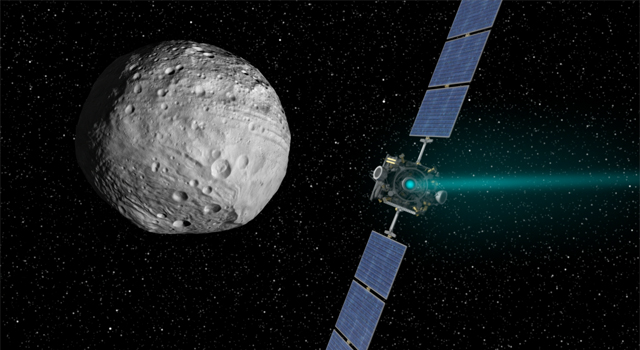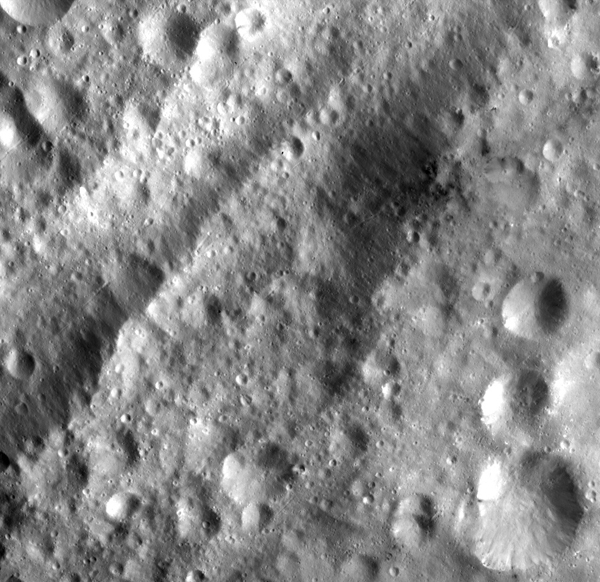Dawn’s Stellar Anniversary
Thursday, September 27th, 2012
As NASA’s Dawn spacecraft makes its journey to its second target, the dwarf planet Ceres, Marc Rayman, Dawn’s chief engineer, shares a monthly update on the mission’s progress.

Artist’s concept of NASA’s Dawn spacecraft. Image credit: NASA/JPL-Caltech
Dear Dawnniversaries,
On the fifth anniversary of the beginning of its ambitious interplanetary adventure, Dawn can look back with great satisfaction on its spectacular exploration of the giant protoplanet Vesta and forward with great eagerness to reaching dwarf planet Ceres. Today Earth’s robotic ambassador to the main asteroid belt is in quiet cruise, gradually reshaping its orbit around the sun so it can keep its appointment in 2015 with the mysterious alien world that lies ahead.
This anniversary resembles the first three more than the fourth. Its first years in space were devoted to spiraling away from the sun, ascending the solar system hill so it could gracefully slip into orbit around Vesta in time for its fourth anniversary. One year ago, Dawn was in the behemoth’s gravitational grip and preparing to map its surface in stereo and make other measurements. The subsequent year yielded stunning treasures as Dawn unveiled the wondrous secrets of a world that had only been glimpsed from afar for over two centuries. While at Vesta, it spiraled around the massive orb to position itself for the best possible perspectives. Its final spiral culminated in its departure from Vesta earlier this month. Now for its fifth anniversary, it is spiraling around the sun again, climbing beyond Vesta so that it can reach Ceres.
For those who would like to track the probe’s progress in the same terms used on previous (and, we boldly predict, subsequent) anniversaries, we present here the fifth annual summary, reusing the text from last year with updates where appropriate. Readers who wish to cogitate about the extraordinary nature of this deep-space expedition may find it helpful to compare this material with the logs from its first, second, third, and fourth anniversaries.
In its five years of interplanetary travels, the spacecraft has thrust for a total of 1060 days, or 58 percent of the time (and about 0.000000021 percent of the time since the Big Bang). While for most spacecraft, firing a thruster to change course is a special event, it is Dawn’s wont. All this thrusting has cost the craft only 267 kilograms (587 pounds) of its supply of xenon propellant, which was 425 kilograms (937 pounds) on September 27, 2007.
The fraction of time the ship has spent in powered flight is lower than last year (when it was 68 percent), because Dawn devoted relatively little of the past year to thrusting. Although it did change orbits extensively at Vesta, most of the time it was focused on exactly what it was designed and built to do: scrutinize the ancient world for clues about the dawn of the solar system.
The thrusting so far in the mission has achieved the equivalent of accelerating the probe by 7.14 kilometers per second (16,000 miles per hour). As previous logs have described (see here for one of the more extensive discussions), because of the principles of motion for orbital flight, whether around the sun or any other gravitating body, Dawn is not actually traveling this much faster than when it launched. But the effective change in speed remains a useful measure of the effect of any spacecraft’s propulsive work. Having accomplished slightly more than half of the thrust time planned for its entire mission, Dawn has already far exceeded the velocity change achieved by any other spacecraft under its own power. (For a comparison with probes that enter orbit around Mars, refer to this earlier log.)
Since launch, our readers who have remained on or near Earth have completed five revolutions around the sun, covering about 31.4 AU (4.70 billion kilometers or 2.92 billion miles). Orbiting farther from the sun, and thus moving at a more leisurely pace, Dawn has traveled 23.4 AU (3.50 billion kilometers or 2.18 billion miles). As it climbed away from the sun to match its orbit to that of Vesta, it continued to slow down to Vesta’s speed. Since Dawn’s launch, Vesta has traveled only 20.4 AU (3.05 billion kilometers or 1.90 billion miles) and the even more sedate Ceres has gone 18.9 AU (2.82 billion kilometers or 1.75 billion miles).


























